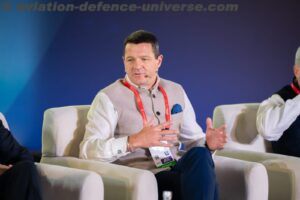 Toulouse. 15 July 2018. As leader of the Urban Air Mobility Initiative supported by the European Commission, Airbus is uniting a broad range of public and private stakeholders to make the most out of ground and air transport solutions, city by city.
Toulouse. 15 July 2018. As leader of the Urban Air Mobility Initiative supported by the European Commission, Airbus is uniting a broad range of public and private stakeholders to make the most out of ground and air transport solutions, city by city.
The world’s cities are growing in both size and number. By 2030, 60% of people will live in urban areas, placing an increasing strain on our mobility infrastructure. As cities get ever larger, enabling efficient, sustainable, affordable and effective urban mobility will become a more pressing challenge.
Airbus believes bringing urban mobility into the third dimension – the airspace above our cities – will help overcome this challenge and transform our cities for the better
For several years, the company has been working on a portfolio of urban air mobility-enabling innovations: development of two electric vertical take-off and landing demonstrators, Vahana and CityAirbus, is well underway, with first flights at the end of 2017 and 2018 respectively; on-demand helicopter booking platform Voom was recently launched in Brazil and Mexico; Skyways, unmanned delivery drones, will soon be trialled on the campus of the National University of Singapore; and Altiscope will support integration of unmanned aerial vehicles into airspace.
Perhaps greater than the technological hurdles, however, are the challenges of urban integration, public acceptance and air traffic management. Cross-sector collaboration is essential in overcoming these challenges, which is why Airbus is proud to lead the Urban Air Mobility (UAM) Initiative, which is supported by the European Commission and is part of the wider European Innovation Partnership on Smart Cities and Communities.
The partnership brings together cities, industry, small businesses, banks, research institutions and other entities from across Europe. Its aim is to connect diverse stakeholders and find scalable and replicable solutions that will ultimately improve the quality of life for EU citizens, from better mobility to greener buildings.
“We welcome that leading cities such as these are joining the EIP- SCC. It shows the growing dynamics and consciousness that multimodal transportation is identified as an opportunity and challenge for Europe.” – Nathalie Errard, Head of EU & NATO Affairs at Airbus in Brussels
Mobilising an entire ecosystem – Managing the partnership’s UAM Initiative is Vassilis Agouridas, Senior Manager Strategic Innovation at Airbus Helicopters. “The EIP-SCC is an open marketplace,” he explains. “Urban air mobility is bigger than any one company or companies. Our aim is to match cities across Europe with stakeholders interested in launching practical demonstration studies of solutions featuring UAM. As leader of the Initiative, Airbus coordinates those involved and seeks to mobilise the entire ecosystem.”
The Initiative is multi-faceted and goes far beyond testing technology: projects will help develop solutions for urban integration and infrastructure, public acceptance and automated air traffic management. “Drones offer exciting opportunities for new services and business models, particularly in our cities,” says Violeta Bulc, European Commissioner for Mobility and Transport. “At the same time, we need to ensure that operations taking place above our heads are safe, secure, quiet and clean.”**
A number of cities are currently joining the UAM Initiative, with Geneva, Hamburg, Ingolstadt and Ghent among the first. “We welcome that leading cities such as these are joining the EIP-SCC,” says Nathalie Errard, Head of EU & NATO Affairs at Airbus in Brussels, who has been involved with the partnership since it started. “It shows the growing dynamics and consciousness that multimodal transportation is identified as an opportunity and challenge for Europe.”
“UAM isn’t science fiction anymore. We are in the process of making it a reality.” – Vassilis Agouridas, Senior Manager Strategic Innovation at Airbus Helicopters
Establishing what cities need – Once the line-up of participating cities has been finalised, demonstration projects, led by the cities, will be defined and prepared, before receiving approval to commence in 2019. This will require the establishment of technical, legal and infrastructural requirements, before selecting technological hardware. “We always start from the city, from their mobility need. Whatever we do has to satisfy that need,” says Agouridas. “It could be a desire to explore air taxis as part of a city’s multimodal transport solution or how to use drones for faster delivery of critical medical supplies. The specific use cases will be defined by each city over the coming months.”
Public acceptance is fundamental, he believes – these are solutions that have not been seen before. “We have to learn not only what citizens think, what the constraints might be and how we can reach compromises if necessary, but also how to actively engage citizens as co-creators of multimodal mobility solutions. Ultimately, this is about our lives, how we move. UAM isn’t science fiction anymore. We are in the process of making it a reality.”
Three questions with Eduardo Dominguez Puerta, Airbus Head of Urban Air Mobility – Eduardo Dominguez Puerta, Head of Urban Air Mobility at Airbus, sat down to discuss the importance of urban air mobility in our cities and Airbus’ role in the European Initiative.
What benefits will this involvement in the EIP UAM Initiative bring to Airbus? Today, city authorities and planners do not yet recognise the sky above their cities as a potential solution in the urban transport mix. This European Initiative allows air and ground mobility players, alongside citizens and other key stakeholders, to work collaboratively on real mobility challenges to devise the best possible comprehensive mobility solutions for their particular cities and regions.
What specific expertise is Airbus able to contribute to the Initiative? Airbus has been flying passengers safely for nearly 50 years, so the company offers reassurance to cities and partners looking to bring urban mobility into the third dimension. Airbus also brings a wealth of expertise in dealing with complex systems integration and certification, on top of its know-how in manufacturing fit-to-fly vehicles.
Why is UAM such an important topic for our cities and how will the EIP UAM Initiative help our future urban environments? Cities are increasingly saturated. Traffic is a headache for the average city dweller and citizens are begging for an alternative. This is why many cities are taking an active role in driving change. They have a strong interest in exploring the feasibility of integrating urban air mobility with other ground transport options.


























































































































